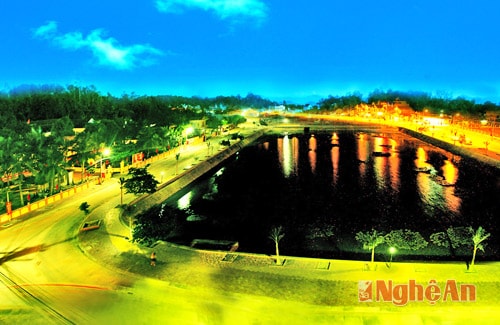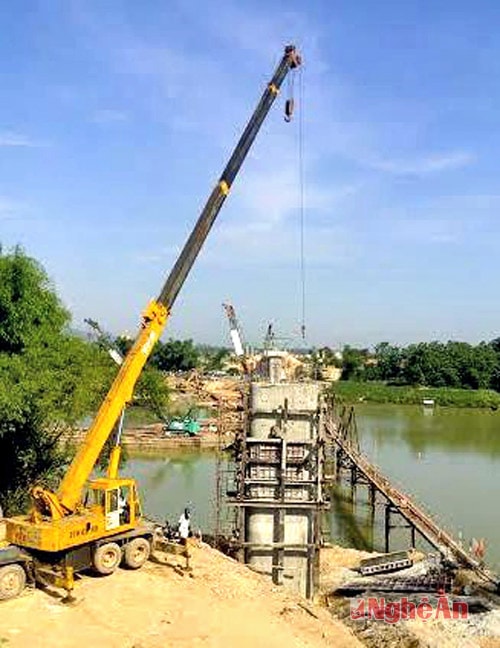The place where the city is located
(Baonghean) -The district town of Thanh Chuong midland district has surprised people in recent years with its modern appearance and the dreamy mountain town look. This change has caused prejudices and the will to move the district town to the Ro - Vo Liet area - where the French chose to set up the district office during feudal times - to gradually fade away...
 |
| Thanh Chuong town center lake. Photo: Ha Lanh |
I just want to call the district town located in that mountainous area as its real name: Dung Town.
Well, the State document when establishing this town named it “Thanh Chuong Town”, but many documents now still write it as “Dung Town”, which makes many local elders angry; although, when I asked about the meaning of the word “Dung”, no one knew?!
Then, I have to quote the poem of poet Che Lan Vien: "When we are here, it is just a place to live/When we leave, the land suddenly becomes the soul", to ask for an appointment to meet Mr. Dang Anh Dung - Standing Deputy Secretary of Thanh Chuong District Party Committee, who is originally from Cat Ngan, now has become a citizen - a citizen of Dung, in whose blood of literature and art he once wrote meaningful articles for this "place to live". In the early summer afternoon, the oppressive air has been heard lurking Lao wind, stirring up clouds of red dust in front of the construction site of the new Dung bridge worth around 160 billion VND. Time has shown that every time this town builds another large public project, it is a pressure for an urban breakthrough not only in trade and services, but from there, people are also happily welcomed with new cultural and spiritual values to affirm that a city center with a long history is not necessarily superior. Dung town does not have the geographical history and urban age of Do Luong, Thai Hoa, Sa Nam towns... but the "harboring" and struggles during the fierce war against the US to the ups and downs of affirming its position as today have created for this town a true urban residential value.
“When will Truong Dung pass/ Let’s go through Truong Rang, let’s go through Truong Si” - I brought that heartbreaking song from the deep thoughts of our ancestors that I heard from Mr. Dang Anh Dung, to Thanh Dong commune to meet Mr. Vo Hanh - former Chairman of Thanh Chuong district in the period of 1970-1974. At the age of 83, Mr. Hanh is still quite lucid. The story of an old man and a young man goes back to the early years of the last century, when Dung market was the most vivid expression of the name of a Truong area. The boy Vo Hanh, at the age of seven or eight, followed his mother to Dung market to sell sweet soup, banana bunches... and began to hear the words revolution and communism from those markets with few leaf shops. Truong Dung was previously considered to be dangerous and deserted, starting from the Nguoc hill, a small road winding between the dense mountain roofs and sparsely populated with “a few barbarians” (a word borrowed from Mrs. Huyen Thanh Quan - PV).
Further up is Truong Rang, where the French military post that initiated the Do Luong mutiny of Doi Can was located. Next is Truong Si, where there is Si market... Where the town market is now, there is a banyan tree where, according to Mr. Vo Hanh, during the Nghe Tinh Soviet period (1930 - 1931), the young communist who was admitted to the Party at the age of 16, Vo Thuc Dong (he was a famous politician of Vietnam), from Thanh Ngoc commune, climbed up to plant the red hammer and sickle flag (?)... People today still call the town market Da market. Mr. Vo Hanh's hard-working mother, the Si market, Dung market, was also a veteran party member, soon following the patriotic example of her father and brother in the pre-uprising days. Dung, therefore, is also a land with a latent patriotic spirit.
Thus, right before the August Revolution, Truong Dung was a remote and mysterious place for travelers with a route of Truong connecting Truong. When the revolution came, the farmers had fields, Dung was still a Truong area with few farmers. Until 1957, to correct the land reform, the district's provisional executive committee invited the elders to participate to regain prestige with the people. The elders fiercely debated where to place the "brain" of the district leadership. Two developing areas at the two ends of the district such as Cat Ngan (Cat Van) were influenced by Do Luong's trade; the lower district of Cho Con was influenced by Nam Dan and Vinh; the location of Ro (Vo Liet) was proposed for selection, but that land was originally a flood area, and the fields were classified as "first-class fields" that needed to be prioritized for agriculture, so in the end the elders decided to "establish the capital" in Dung even though the road traffic for Dung was a deadlock...
Now, in the town next to the district post office, there is still a brick chimney standing tall, a testament to Dung's heroic labor and resistance against the US, with many industrial establishments such as paper, sugar, noodles, fish sauce, agricultural machinery cooperatives, etc. of the province moving to operate here from 1959 to 1960. In 1965, the US bombed fiercely, there was a day when Dung endured 3 hours of bombs and bullets, the district agencies had to evacuate to neighboring communes; Until 1972, they gradually moved back, the office buildings were still old wooden houses bought from the people... Before and after 1985, when the decision was made to establish the town, in addition to the Dung suspension bridge project "inserting a second milestone into the mysterious Lam river after Ben Thuy bridge" ("Spring Bridge" - Nguyen Huy Can) and the largest People's Theater in the province at that time (after the Provincial Labor Cultural House), the midland district town still bore the heavy imprint of the battlefield and the subsidy mechanism with only one kilometer of asphalt road running through it like that throughout the long years until the Doi Moi period...
 |
| Construction site of the new Dung Bridge. Photo: D.S |
And until today. This early summer afternoon. Walking on the corridor of the central lakes of Dung town, paved with beautiful bricks, under the purple flowers of the Lagerstroemia blossoming in the sky of the midlands, I looked around the town with all the shapes of houses, offices, and spacious restaurants reflecting on the blue lake; and returned to a personal memory in 1982, when I brought with me the December standard of rice from the Cooperative in Thanh Khai in the lower district to study in the gifted class in Dung, 15 kilometers from home. The only main road through the district town at that time was always covered with a layer of red mud after each rain, and on the roadside there were still bamboo and palm trees.
Today, Dung Street, off the main route of National Highway 46, is a flat asphalt-paved hamlet road connecting with convenient traffic routes to communes in the district. Also from those traffic conditions and good service development, Dung has increasingly "attracted" economic, cultural and social needs, affirming the economic and political center of the district. But most noteworthy is the 655-hectare urban planning for about 1,000 residents in 15 hamlets, with abundant land for cultural institutions and schools, enough to see a local vision. That vision, such as the conversion of plowed fields into two vast lakes in the heart of town in 2005; But as Mr. Dang Anh Dung said, it is also a breakthrough in awareness, ending the scene of "urbanites carrying plows on the asphalt road", so that now every morning and every afternoon there are bustling footsteps of people leisurely strolling and practicing health exercises, creating a strangely civilized and peaceful street!
Few towns have two large markets like Dung. Above is the bustling town market, below is the afternoon market at the end of the day, which is equally bustling. Thanh Chuong products are abundant in these two markets. Each season has its own vegetables and fruits: canarium, guava, banana, jackfruit, green tea... to small fish and shrimp caught fresh from ponds, rivers, streams, and fields. Speaking of Dung cuisine, from the popular shops to the big restaurants like Pho Huyen, Song Linh... all have a rich variety of dishes made from famous local specialties such as canarium, hill chicken, cooled fish, pickled bamboo shoot soup... one bite is unforgettable. Business is prosperous, the architecture of the houses has also changed quickly to catch up with the new construction in the center of the district. High-rise buildings have sprung up, above for living, below for business services, rentals... but the sidewalks have been strictly shortened, the people have taken care of environmental sanitation, planted flowers and ornamental plants; The urban lifestyle and the civilized buying and selling rhythm have matured, adding to the urban landscape of an attractive mountain town in the future. At the end of 2014, when Dung 2 Bridge is completed, connecting the main road to the resettlement area of Ban Ve Hydropower Plant, the town market will surely have more colorful brocade skirts of the Thai people in the resettlement area, weaving the joyful rhythm of the streets.
The afternoon in the midlands slowly falls. The mountain town gradually lights up. The lake surface shimmers with fragrant May lotus flowers. “When will Truong Dung be over…” - the old deserted road is now a dreamy mountain town, the gentle slope of the asphalt road seems to contain a farewell. Yes, goodbye mountain town! Say goodbye to the bright smiles of young men and women enjoying the cool breeze by the lake, exchanging the purple color of the Lagerstroemia flowers; say goodbye to the old man with white hair and beard who is carefully tending the flower pot in front of the door; say goodbye to the moonlight of the mountain town that has just had time to turn the bustling city scene into gold. The old deserted Truong Dung road has ended, so now I can carry with me a part of the affection of my hometown and the district town...
D.S






